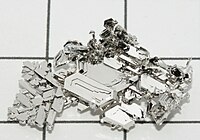
Photo from wikipedia
Electrochemical water splitting is considered to be a promising renewable hydrogen generation technology but is significantly limited by the kinetically sluggish oxygen evolution reaction (OER) at the anode. Herein, a… Click to show full abstract
Electrochemical water splitting is considered to be a promising renewable hydrogen generation technology but is significantly limited by the kinetically sluggish oxygen evolution reaction (OER) at the anode. Herein, a silver nanoparticle decorated nickel-cobalt (oxy)hydroxide composite is fabricated on nickel foam (Ag@NiCo(OH)x/NF) via electrodeposition followed by spontaneous redox reaction. Benefitting from the synergetic contributions of an amorphous/crystalline phase, abundant artificial heterointerfaces, and a 3D porous architecture, the as-designed Ag@NiCo(OH)x/NF shows substantially enhanced electrocatalytic performance toward the OER and urea oxidation reaction. Impressively, in the urea-assisted alkaline electrolyzer (coupled with commercial Pt/C on NF as the cathode) for hydrogen production, a cell voltage of only 1.49 V is required to deliver a current density of 50 mA cm-2, much lower than that of traditional water splitting (1.69 V). Importantly, this work represents a facile and feasible method to exploit efficient self-supported electrocatalysts toward overall water splitting and urea-rich wastewater purification.
Journal Title: Dalton transactions
Year Published: 2022
Link to full text (if available)
Share on Social Media: Sign Up to like & get
recommendations!